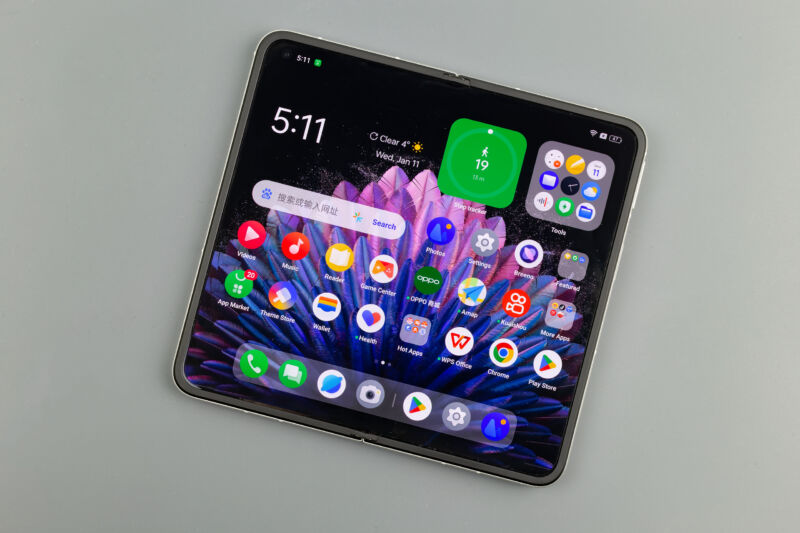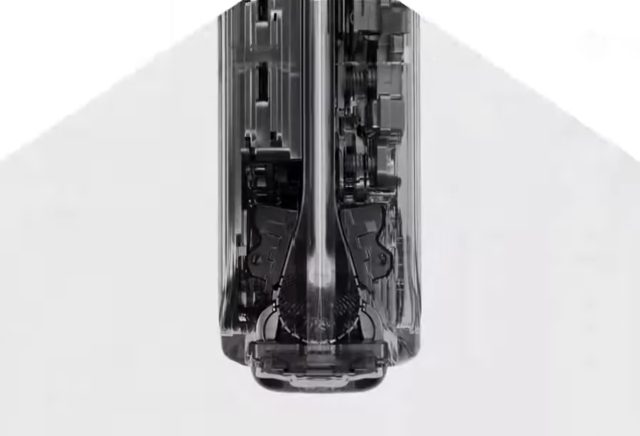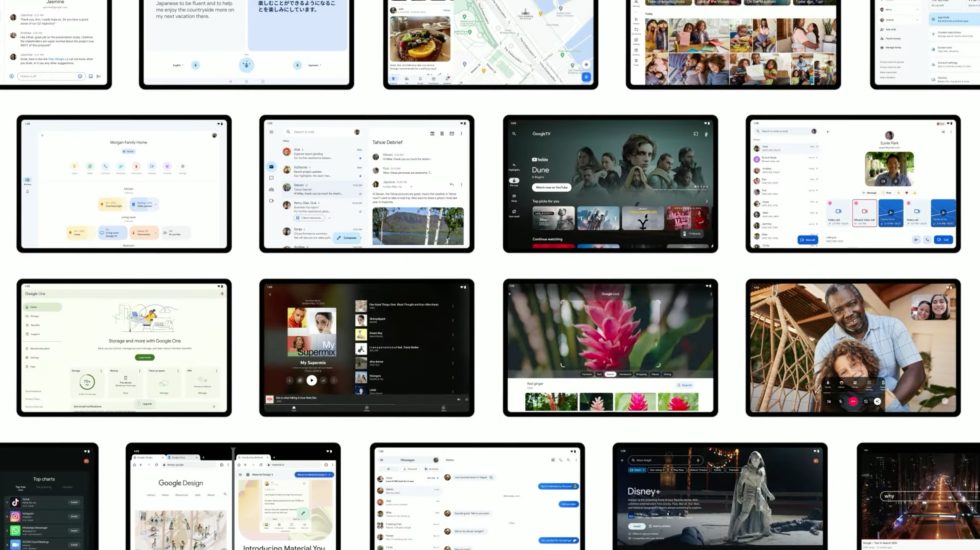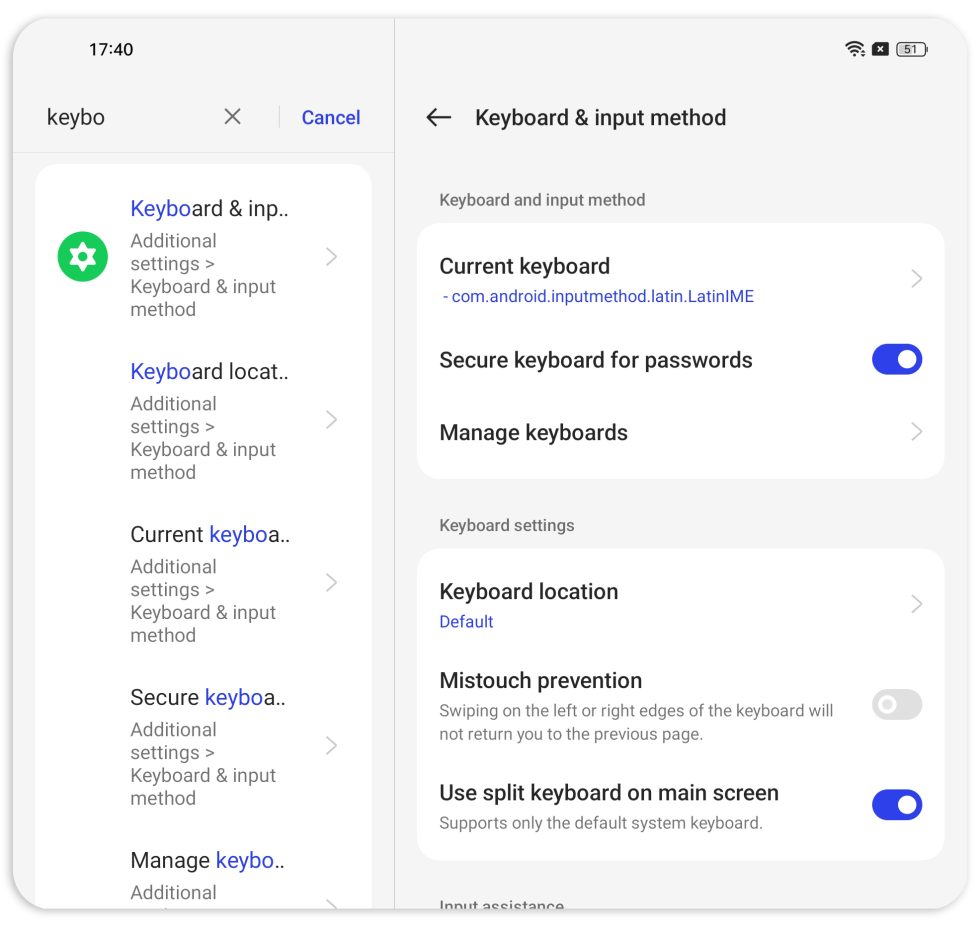Oppo Find N2 Review: Beautiful Hardware That Android Just Cant Deal With

One of the most interesting designs we've seen in the wild world of foldable smartphones is the Oppo Find N2. The unique form factor and design make it the lightest foldable tablet on the market, and it has one of the least noticeable creases of any foldable device.
While the phone isn't shipping in the US, Oppo's sub-brand OnePlus shares a lot of details and software with the company, so we could see something similar here one day. But the limited distribution isn't a huge loss as Android is a disaster for a device this size. Of course, the device needs to display something other than the phone UI on the large internal screen, but Android is loaded on the phone UI anyway. This means that a large screen is often the worst user experience because Android doesn't know what to do with it.
The phone also reveals a dark Android secret: even if you explore the developer options and run everything as a tablet app, these apps won't look good on foldables either. Google's plans for a tablet renaissance revolve around 16:10 ultrawide tablets, which squeeze those interfaces into the smaller square screens of foldable devices. Apps designed for tablets are not good enough for foldable devices.
Material
I have nothing but good things to say about the Oppo Find N2's hardware. At 132.2mm, it's as tall as the iPhone 13 Mini (131.5mm), but with a normal width of 72.6mm when folded, it doesn't feel small in the hand. (mini width is 64.2 mm). The result is a large and small 5.54-inch front-facing display with an 18:9 aspect ratio, which feels like a throwback to the days when ultra-wide 19.5-aspect-ratio displays didn't exist not. thick tops and bottoms, but this device has a similar shape on the front with bezels as small as you like.
The Find N2 also folds very easily. We usually don't pay too much attention to the weight of the phone, but some foldable devices are so heavy that it is difficult to fit them in your pocket. A typical large phone weighs between 220 and 240 grams. Samsung's heaviest foldable device was the Galaxy Z Fold 2 at 282 grams and the Fold 4 at 263 grams. The Oppo Find N2 weighs 233 grams, which is lighter than the iPhone 14 Pro Max. The reasonable weight makes the Find N2 look more like a regular phone than a giant brick.
| QUICK FEATURES: Oppo Find N2 | |
|---|---|
| FILTER | Screen: 5.54" 120Hz 2120x1080 Internal: 7.1 inches, 120Hz, 1920x1792 |
| SAY | Android 13 |
| CPU | Qualcomm Snapdragon 8+ 1st Gen |
| tame | 12 GB |
| STORAGE | 256 GB |
| ONLY | Wi-Fi 6, Bluetooth 5.3, GPS, NFC |
| PORTS | USB-C |
| CAMERA | Main camera 50 MP, telephoto 2x 32 MP, wide-angle 48 MP, front 32 MP |
| SIZE | Open: 132.2 × 140.5 × 7.4 mm Folded: 132.2 × 72.6 × 14.6 mm |
| LEICESTER | 233 g |
| BATTERY | 4520mAh, 67W charging |
| STARTING PRICE | ~ 1137 USD (8000 RMB) |
| OTHER BENEFITS | Its fingerprint reader |
However, it is still a brick shape. The phone is officially listed as 14.6mm when folded, but it's without a noticeable camera bump. The thickness of the phone with the notch included is 18mm. We weren't fans of the thinner smartphone wars of the past, but when a device is twice as thick as a typical 8mm smartphone, thin matters.
Xiaomi's Mix Fold 2 and Huawei's Mate X3 have done an amazing job of slimming down - the two halves are just over 5mm thick, and when folded they're about 11mm, 12mm. The drive is from Microsoft's (probably defunct) Surface Duo line, which measures 9.9mm when folded.
Since the device is incredibly small, your index finger often touches the camera bump when you hold the phone. When your fingers come into contact with something other than smooth, slick glass, it helps you get a better grip—the bump is like a little shelf you can rest your index finger on.
The screen is similar to the usual Samsung foldable boot, with a flexible OLED screen, an ultra-thin layer of glass and then a top layer of non-removable protective plastic. However, the plastic bezel around the screen makes it difficult to use the standard Android swipe gestures – you'll be constantly hitting your finger on the raised ring.
As with the Moto Razr, the screen doesn't have the 'creases' you usually see on Samsung devices, thanks to the teardrop screen when folded. In the folding area, the folding supports behind the screen can move sideways when the device is closed to prevent the screen from being compressed.

When open, the screen hinge area isn't perfect, but it's the best I've seen on any foldable device. The hinge area isn't exactly flat—there's still a notch in the middle of the phone that distorts slightly—but it's a lot better than what Samsung usually offers. However, the ultra-thin glass is not that hard and you can feel all the mechanical parts under the screen.
Being a Chinese phone made for China, it doesn't come with Google Play, but that's surprisingly easy to fix. You usually need the Play Store and a number of dependent APKs such as Google Play Services, Google Account Manager and Google Services Framework. Chinese phones now come with all these dependencies; they are right next to him. To my surprise, I only had to download one file, an APK from the Play Store, and everything worked. However, some apps are coded in Chinese.
The hardware is interesting and truly unique, but Android is unfortunately a disaster when it comes to interface design on such a small device.
Android doesn't have an answer for foldable devices

Let's talk about the problem with Android and flip phones. The image above is from Google I/O 2022, where Google announced the Pixel tablet and its triumphant return to big-screen design. Google's typical approach to its projects has meant that the company has abandoned tablets entirely for years, leaving most of Android and many of Google's flagship apps off the big screen. You have an extended phone interface and that's it.
Over the past 18 months, however, Google has refocused on tablets, which it abandoned a few years ago. Released in March 2022, Android 12L was a tablet-specific release that updated some key parts of the Android user interface with split-screen interfaces and a bottom dock for app icons. The initial release of the Pixel tablet inspired Google to revive tablet app design, promising "over 20 optimized Google tablet apps" at I/O. Although the offer is not yet there, the company has fulfilled that promise.
However, these are tablet apps and it is a foldable device. Again, check out this collage of tablet app designs compared to the Find N2. The design of every Google tablet suddenly focuses on 16:10 style devices. For example, the upcoming Pixel tablet has an 11-inch 2560x1600 display with a 16:10 aspect ratio, and that's what tablet apps are all about: big screens with lots of horizontal space. This design doesn't necessarily fit the Find N2's square 7-inch screen. When you open the app on the Find N2's internal screen, you'll never know if you're getting a tablet or phone app — and neither option looks that good.
- It's a 3.3-inch Palm phone that shows more list items than the Oppo's giant screen.Ron Amadeo
- Play Store on Pixel 7 Pro (left) and Oppo Find N2.Ron Amadeo
- Everything looks good on the front screen of the Oppo Find N2.Ron Amadeo
As always, phone apps look terrible on the big screen. Android scales apps according to screen width. So opening a phone app on a large screen doesn't just make the elements wider and taller; often make things bigger . Phone apps everywhere use ridiculously large screen layouts, and it's usually more convenient to just close the phone and use the small front screen instead.
Play Store is a clear example of this. In the "Top Apps" list, you will see six entries on the 5.5-inch external display. The inner screen, which is twice the size of the outer screen, shows three inputs. Everything grows when it is wide.
Tablet apps aren't much better. They often switch to a two-panel display mode that doesn't fit on a square screen. An app like Gmail suddenly starts showing more icons per line in tablet mode because it expects a wider screen, while Find N2 creates a narrow layout with lots of cropped text. Even the built-in settings app, which you'd hope was meant for the phone, doesn't quite fit the screen.
The left panel contains all the main sections of the settings program, but it is so narrow that you can only see a word or two before the line breaks. Since the settings are designed for a widescreen device, they are split 33/66 between the left and right sides. An interface designed for a square screen will have a 50/50 split and will probably look good. Unfortunately, Oppo just added a 16:10 interface to the display and turned it off.

Google doesn't design stackable UIs and they really should. Foldables are too big for a phone UI and too small for a 16:10 tablet design. They want a design that falls somewhere between these two extremes. The company has already thought about foldable devices, for example with Android 10, which allows the resizing of applications from the outer screen to the inner screen. But it's not foldable design , where someone looks at the size of the average foldable screen and designs an interface around that. The basic Android OS and all the apps are waiting for a long, thin phone or a fancy ultra-wide tablet to replace the laptop, so both types of apps don't look good on these devices.
Lots of scaling issues and developer settings don't help
The default Find N2 software scale also appears to be incorrect. Even if you ignore the foldable 7-inch display and look at the 5.54-inch front display, everything about the Find N2 is large.
It's not just a matter of preference – if you take the Pixel 7 Pro to its default settings and transfer it to the Find N2, you'll find that the fonts and icons on the Find N2's 5.54-inch display are significantly is bigger. there really is. On the 6.7-inch Pixel 7 Pro. One reason is that nothing on the Find N2 lends itself to tablet mode, or even side-by-side split-screen mode, because the main user interface is so large.
Android offers a consumer-grade scaling option in the display settings, but on the Find N2 you can only choose between two sizes: "Regular" and "Small". "Small" should be the default, as fonts and icons are closer to the normal size of Pixel 7 Pro settings. There is also an extension option, explicitly called "minimum width", which will allow you to enter any scale. However, this creates a number of problems.
First, it is impractical to suggest that consumers access developer settings to fix basic UI issues, as some apps (financial apps and online games) will be locked if you use developer options. Second, changing the developer zoom settings causes a bug that causes the camera notch to appear in the wrong place on the screen. You'll end up with a circle of black pixels next to the camera hole that don't line up with it.
- Gmail on external screen (left) and internal screen (right). Note that even the same app has completely different scales depending on the screen.Ron Amadeo
- Chrome works well with a built-in display because of the scale of web pages. However, the user interface still looks very large.Ron Amadeo
- Games on the internal screen are pretty good.Ron Amadeo
- Switching from widescreen to closed screen does little.Ron Amadeo
- It is basically the same size as the external screen.Ron Amadeo
- But if you can get older content in 4:3, the Find N2 is great.Ron Amadeo
Third, and this is the real problem, even with developer settings, there is no "correct" solution, because the external and internal screens must have the same scale value, and their densities are very different. There's simply no way to control two screens independently, and until Android fixes this problem, manufacturers will have to figure out how to make it work. The two Oppo screens are quite far apart in terms of density. The flexible internal screen of Oppo Find N2 is 370ppi and the external screen is 429ppi.
Fonts and icons cannot be the same size on both screens because they must have the same scale value. Using the developer options is inconvenient because there is no scale value that works well for both screens. If you choose something suitable for the internal display, the elements of the external display will look microscopic. If you choose something suitable for the external display, everything will look good on the internal display.
All foldable Android devices have this problem, but a company like Samsung avoids the worst of them by having a closer screen density in the Fold 4: 373ppi inside and 401ppi outside. Oppo chose the screens far enough to turn a slight annoyance into something that spoils the user experience. In the future, Android should provide "Screen 1" and "Screen 2" settings to provide completely independent options on both screens. Meanwhile, manufacturers have to choose two identical screens.
The home screen is bad and the Oppo skin makes it worse
Home screen is very important in Android. It's the main interface and, along with the notification bar, it's the starting point for every task you perform on your phone. It is extremely important to use the right home screen for your work. Android is generally very good at this, allowing users to customize their default home screen or set many custom third-party options.
Surprisingly, the Oppo Find N2 skin does not allow you to change the default home screen. Why should a company do this?
The splash screen is locked to Oppo's default Homebrew option, and the default boot option never shows anything other than "boot system". Oppo's home screen isn't top notch, and not even much development is being done. There is no obvious reason to lock users into it – there are no ads and Oppo does nothing to promote its services. It is a simple desktop launcher with no frills.
The biggest problem is again the lack of zoom options on the main screen. The best home screen apps (and even bad home screen apps like Pixel Launcher) let you choose the size of the icon grid. While the standard for a typical phone might be four tabs wide and seven tabs high, you can add more rows or columns to make them narrower. The default main screen density is fine, but still the overall phone scale doesn't work.
Diving into the developer options to change the overall screen scale will also make the home screen look uglier and more distracting. The screen size doesn't make the main screen look tighter; it just makes the icons smaller and further apart. The goal was to highlight more icons and perhaps a switch to display some of Android's larger videos. Even if Oppo is sure to change the default home screen to foldable Android, this problem will still be difficult to solve.
The home screen needs special care to perform well in triple home storage; You can't just take a grid of app icons designed for a large internal screen and compress it onto an external screen or vice versa. The Oppo launcher expands well and shows one home screen on the external screen and two internal screen pages on the external surface. No third party launchers that I know of do this. One day this may change, but it will be useless for Oppo customers due to the blocking of the home screen.
Complex desperate feelings in polishing
Find N2 looks unfinished as Oppo made several mistakes. When it was necessary to buy parts, the company chose two displays with different densities. Android can't fix this, so one screen isn't the same size as the other.
The scale of the user format is set to "super large" by default, and even the small version looks cramped. The developer settings haven't found a solution that works for displaying the play, and you can't change the scale of the main screen for it to apply because the main screen has no relation to the scaling parameters. Oppo also decided to use a hostile workaround to block third-party home screens, so if there was a good stock home screen app that could fix the situation, you wouldn't be able to use it. Due to these problems with the use of Oppo Find N2, it is possible to use a poorly configured screen, which cannot possess the characteristics of your driver and is set to 800×600 by default.
It's a shame, because Oppo's hardware is beautiful. A small storage spacer to locate it is very easy, and you even have a decent chance of using the front screen with one hand. Due to the fact that it is so short, the index finger easily rests on the lower part of the camera protrusion, so that its retention is locked.
If Australia's interfaces were implemented for a square screen, this would be the location. But apps for tablets represent Android for widescreen devices, and the same goes for most of the video content. The only area in which the Oppo Find N2 is located are web pages intended for everyone, and some games, and this is not enough.
Good
- Beautiful, compact equipment, surprisingly light and portable.
- The internal view with a frequency of 120 Hz looks good.
- Thin bezels all around
- Super fast charging 67 W
It's bad
- Oppo chose twelve different screens, and Android can't fix that.
- Android doesn't scale very well with square screens, choosing between narrow widescreen apps for tablets and stretched apps for phones.
Ugly
- How can you justify blocking users in the app on the main screen?


